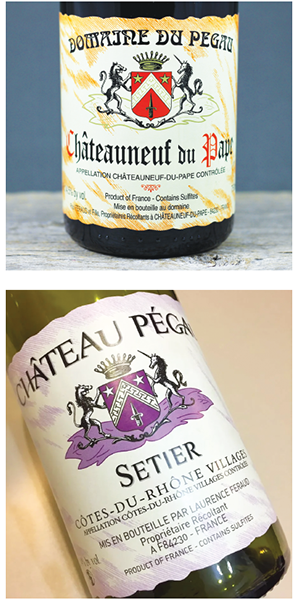Like so many of the great wine regions of the world, a river runs through France’s Rhône Valley. The Rhône River shapes the landscape and lends its character to the wines made there.
Viticulture arrived in the region with the Greeks in the 4th century BC but flourished during the Roman Empire. The river was used by the Romans as a trade route. They established extensive terraced vineyards in the area and developed a wine trade that thrived until the Empire collapsed.
The area is well suited for viticulture with diverse soils and drying winds, so grapes continued to be grown in the region and the Catholic Church reinvigorated the industry in the Middle Ages.
The wines were so good that the pope moved the papacy from Rome to Avignon in the Rhône Valley in the 14th century and planted more vineyards to surround the city. There would be seven Avignon popes, and they put their imprint on the region by building the Palais du Papes and a summer house called Chateauneuf du Pape.
Wine regulations would be introduced by 1650 to guarantee the provenance and quality of the wines produced and the river would remain an important shipping route.
This history of quality production led Rhône Valley producers to be at the forefront of the modern wine regulations created in the 20th century, pushing for the Appellation d’ Origine Controlee or AOC status.
RHÔNE VALLEY WINES
The vineyard area spreads over 155 miles from Vienne in the north to Avignon in the south. The Côtes du Rhône is the largest AOC, accounting for almost half of the valley’s production.
 The next quality tier up is the Côtes du Rhône Villages with 22 geographical names added to the label to distinguish the wines provenance; this grouping makes about 11 percent of the region's wine. There are also other small production areas that account for over one-third of the wine.
The next quality tier up is the Côtes du Rhône Villages with 22 geographical names added to the label to distinguish the wines provenance; this grouping makes about 11 percent of the region's wine. There are also other small production areas that account for over one-third of the wine.
The highest quality level in the Rhône Valley are the individual Crus. The Northern Crus produce six percent of the region’s wine while the Southern Crus produce nine percent.
These are wines that are very representative of special sites which showcase each area’s unique territory. It is interesting to note that the majority of the highest quality wines from the Rhône Valley are imported by the United States.
Wine from the Rhône Valley is very drinkable, food friendly, and affordable across all the classifications. Eighty-five percent of the grapes used are Grenache and Syrah with many other side blenders making a total of 34 grape varieties grown in the region. Syrah is the most important grape in the north while Grenache dominates the south.
Certified organic wines represent over 12 percent of the total production with more producers working toward achieving that status as the dry, beautiful Mediterranean climate makes organic grape growing easier than in many other wine regions around the world.
The majority of Rhône Valley wine production is dry, red wine but the region also makes excellent whites and roses as well. There are also some high-quality, sweet dessert wines produced in the region and some sparkling wines made there as well.
Spec’s currently holds approximately 30 different Rhône Valley wines on the shelf, giving islanders an opportunity to get a good taste of this renowned region.
There are several cheap and cheerful Côtes du Rhône options like the very budget-friendly wines by La Vielle Ferme brand by Famille Perrin which make white, rose, and red Côte du Rhône wines for under $16 for 1.5-liter bottles.
A higher priced, but still great-bang-for-the-buck wine, is the Syrah heavy blend by E. Guigal which offers an excellent introduction to the region at approximately $16. The biodynamic/organic offering from Chapoutier Belleruche Côtes du Rhône Rose is a top pick for pink and a great value for under $13.
Up a level, the Domaine de Cabasse Le Rose Villages Seguret features an elegant floral lifted character for $15. The Château Pégau Setier Côtes du Rhône Villages Rouge is loaded with rustic red fruit and spice as well as showcasing the herbaceous garrigue character for which wines grown near the Mediterranean are known. This wine offers excellent complexity for under $19.
The best value cru wine is the Domaine des Remizieres Saint Joseph Rouge for $32. This award-winning red offers rich red fruit with a mineral edge and a hint of oak.
For a splurge-worthy cru wine, try the Domaine du Pegau Reserve Châteauneuf du Pape, a rich and intense red blend made from 13 different grape varieties, primarily Grenache, Syrah, and Mourvedre. Priced at $77, this wine depicts the character that made the region and its red wines famous.
Further exploration of what the Rhône Valley offers can continue with the Poulet & Fils Clairette de Die Tradition sparkling wine made primarily from Muscat and Clairette grapes with low alcohol and a sweet taste that is best enjoyed with salty snacks and is priced at $19.